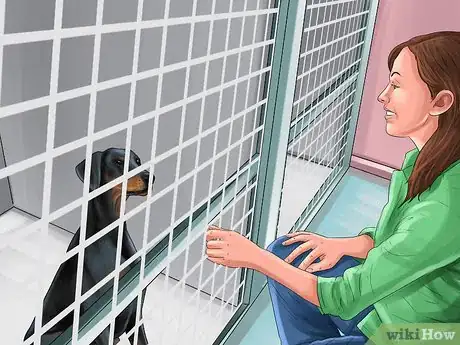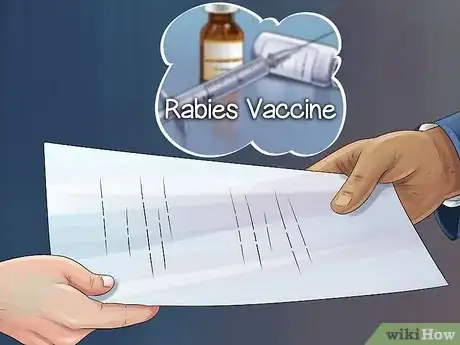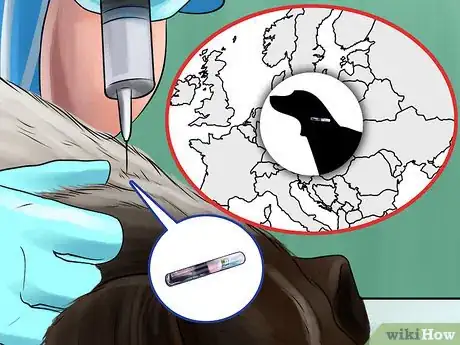This article was co-authored by Ryan Corrigan, LVT, VTS-EVN. Ryan Corrigan is a Licensed Veterinary Technician in California. She received her Bachelor of Science in Veterinary Technology from Purdue University in 2010. She is also a Member of the Academy of Equine Veterinary Nursing Technicians since 2011.
This article has been viewed 32,689 times.
There are many dogs in need of homes all over the world. Many animal rescue agencies can help you adopt a dog in need from another country. However, transferring a dog between countries can be costly and time consuming. You will need to make sure you can afford an overseas adoption. Make sure you fill out all the required paperwork in your country of origin. Your dog should also get any vaccinations necessary to enter the country safely.
Steps
Selecting a Dog to Adopt
-
1Make sure you have adequate funds to adopt a dog overseas. Adopting a dog overseas is not cheap. In addition to an adoption fee, there are costs like travel, veterinarian exams, and fines and fees for transporting a dog in or out of the country. On average, it can cost anywhere between $150 and $2,000 to adopt a dog overseas. Make sure you can get this money together before committing to the adoption process.[1]
-
2Seek out international adoption agencies. You may find a dog you want to adopt while traveling overseas. For example, you may find a stray you want to take in or meet a dog at a local shelter. However, if you simply want to adopt a dog in need from another country, you will have to find an agency to work with that will help you find a dog that works for you.[2]
- Try seeing if there is a branch of the Humane Society operating in the country where you're thinking of adopting a dog. You can also look into Humane Society International, which can help pair you with dogs in need from a variety of countries.
- There are also organizations that can help with cost of transportation, if that's an issue. The nonprofit Pilots N' Paws, for example, works with pilots and other airline officials to help with transportation costs.
- Agencies in some countries will also work to spay and neuter stray dog to help get them adopted out of the country. This is especially common in small island nations.
Advertisement -
3Consider your lifestyle. If you're thinking of adopting a dog, whether from overseas or locally, you should always consider your lifestyle first. Do you truly have time for the responsibility? If you're going to put the time and money into adopting a dog overseas, make sure you are up for the task first.[3]
- Do you have the time and money to dedicate to a dog? Can you provide a rescue dog with the time and attention it will need? Rescue dogs may have special needs, and if you're transporting a dog from another country the transition may be rough. Be honest with yourself as to whether you have the extra time necessary to care for a rescue dog.
- Many dogs from other countries are mixed breeds, meaning that they tend to be healthier and less susceptible to diseases than some purebred dogs.
- If you already found a dog to adopt, think about whether that dog's personality matches with your lifestyle. A very energetic dog, for example, may not work great for you if you tend to stay in a lot and live in a small building. However, if the dog in question is more of a couch potato, it may be a good match for you.
-
4Visit the dog first if possible. The best way to tell if a rescue dog works for you is to visit in person. Interacting with the dog will help you tell whether you and the dog are able to bond. If a trip to the country where you're adopting is possible, make this trip first. It's always better to meet a dog in person before committing to an adoption.[4]
- If you can't meet the dog in person, read as much about it as you can prior to adopting. You may also be able to video chat or call the agency to discuss the dog further. The more information you have, the more likely you will be to find a dog that matches your lifestyle.
Handling Legal Issues
-
1Check legal requirements for your country. When you're ready to start the process of adopting your dog, start by checking regulations in your country. Requirements in terms of veterinary exams, fees, and quarantine periods vary greatly between countries.[5]
- If you're working with an international adoption agency, someone there should be able to walk you through the process.
- You can usually find the information online through a website associated with your government. Organizations like the Centers for Disease Control provide information on overseas adoption for many different countries.
-
2Get a health exam from a local vet. Most countries require a health certificate that will travel with the dog from their native country to their new home. When your dog travels through customs, a veterinarian or customs worker will need to view this certificate to assure your dog is healthy and will not bring any contagious diseases into your country.[6]
- Locate a reputable local vet to perform a basic exam on your dog. Have them fill out any required paperwork assuring your dog's health.
- If you're working with an adoption agency, they may have their own vet that provides exams and health certificates.
- Always check requirements in your own country in regards to paperwork. Some countries may not require a veterinary exam, or may require more than one exam before a dog may enter the country.
-
3Get proof of rabies vaccination when bringing a dog into the United States. Rabies is still a problem in the United States. While rabies has been more or less eradicated in countries like Australia, there are still cases of rabies in the US each year. When bringing a dog into the United States, you are required to get your dog a rabies vaccination.[7]
- If your dog has never been vaccinated before, it needs to be vaccinated at least 30 days before arriving in the United States. Many import requirements will need at least 2 rabies vaccines, so if you are adopting a puppy under a year old, you may need to get them a booster to be compliant.
- You will need a certificate that includes information regarding you and your dog, such as your name and address, a description of your dog, the date of the vaccination, and so on. The vet that performs the vaccination can fill out this certificate.
- Puppies cannot be vaccinated until they're at least three months old. Therefore, a puppy will have to be at least four months old before it can enter the United States. If you're trying to adopt a puppy younger than this, you may need to wait before officially completing the adoption.
-
4Deal with screwworm issues, if necessary. Screwworm is a parasite that is an issue in certain countries. If you're bringing a dog into the United States from a country where screwworm is an issue, you will need a certification stating your dog is screwworm free.[8]
- Screwworm is present in countries such as Kenya, Iraq, Jamaica, Peru, and Nigeria. You can find a full list of countries where screwworm is an issue on the Centers for Disease Control and Prevention website.
- You need to have a certificate filled out by a full-time salaried veterinarian stating your dog has been inspected for screwworm and is screwworm free. This certificate should be filled out at least 5 days before your dog has been shipped to the United States.
-
5Get your dog a microchip when moving to an EU country. Microchips are small chips embedded into your dog's skin that provide identification in the event your dog gets lost. Not all countries require microchips. For EU countries, however, a microchip is required for all dogs entering the country.[9]
- Your dog will need to be microchipped before you travel into an EU country. You will also need documentation verifying your dog has been microchipped.
- Check specific regulations for the country where you're traveling. Some countries will accept any type of microchip while other countries require specific brands of microchips for entry. Check the type of microchip to make sure your dog is complaint, and so that your vet knows what type of scanner to use when checking your dog.
Completing Your Adoption
-
1Check with your airline about flying a dog overseas. If you're taking a dog back with you from vacation, or bringing a dog back after visiting, talk to your airline. Make sure you're allowed to bring your dog on the plane and figure out the cost and requirements for air travel with a dog.[10]
- Airlines often charge extra for you to bring a dog with you. It can cost anywhere between $200 and $2,000 to transport a dog from overseas.
- If cost is an issue, reach out to a charity organization like Pilots N' Paws to see if they can help with some of the cost. If you're already working with an adoption agency, they may be able to have the dog transported for you at a reduced rate.
- Some companies, such as Potcakes in Turks and Caicos, have vacationer fly puppies back with them to their home city to meet their adopted family. Check with your adopting organization to see if a program like this is an option.
-
2Find alternative modes of transportation. If it's not possible to have a dog on an airplane with you, you may be able to check the dog as baggage or unaccompanied cargo. The dog would still be on the plane, but not in the cabin with you. Explore these options if your airline does not allow dogs on the plane.[11]
-
3Undergo an airport inspection, if required. The majority of countries will have some form of airport inspection. This is usually conducted by a veterinarian at the airport. The purpose is to make sure your dog is disease free before it enters your country.[12]
- You may also have to present paperwork, such as a proof of rabies vaccination, at this point. Make sure you have your paperwork ready to go when you meet with an airport veterinarian.
- You want to make sure you enter the country when the airport vet is ready to conduct an inspection. Some airports may not have vets on staff all the time, so getting your dog past customs may require some waiting.
-
4Contact your state animal health officials once you get home. Local regulations for overseas pets vary, even within the same country. Once you and your dog get home, contact state animal health officials. They can help you complete any remaining paperwork to finalize the adoption process.[13]
References
- ↑ http://stories.barkpost.com/rescue-vacation-dog/
- ↑ https://www.outsideonline.com/1785306/how-do-i-get-rescue-dog-home-overseas
- ↑ http://www.humanesociety.org/animals/dogs/tips/choosing_dog.html
- ↑ http://www.humanesociety.org/animals/dogs/tips/choosing_dog.html
- ↑ http://www.hsi.org/issues/street_dog/factsheets/adopting-transporting-pets-internationally.html
- ↑ http://stories.barkpost.com/rescue-vacation-dog/
- ↑ https://www.cdc.gov/importation/bringing-an-animal-into-the-united-states/dogs.html
- ↑ https://www.cdc.gov/importation/bringing-an-animal-into-the-united-states/dogs.html
- ↑ http://stories.barkpost.com/rescue-vacation-dog/
- ↑ https://www.outsideonline.com/1785306/how-do-i-get-rescue-dog-home-overseas
- ↑ http://www.canadianliving.com/life-and-relationships/pets/article/how-to-adopt-a-foreign-dog-or-cat
- ↑ http://www.canadianliving.com/life-and-relationships/pets/article/how-to-adopt-a-foreign-dog-or-cat
- ↑ http://stories.barkpost.com/rescue-vacation-dog/
About This Article
To adopt a dog from overseas, you’ll first need to find an international adoption agency to work with. A simple way to start is by connecting with the Humane Society International. Next, check the legal requirements for your country, which might include veterinary exams, fees, vaccinations, and quarantine periods. Most countries will also require a health certificate to travel with the dog. To learn more from our Veterinary co-author, including how to transport your new dog, scroll down!






































































